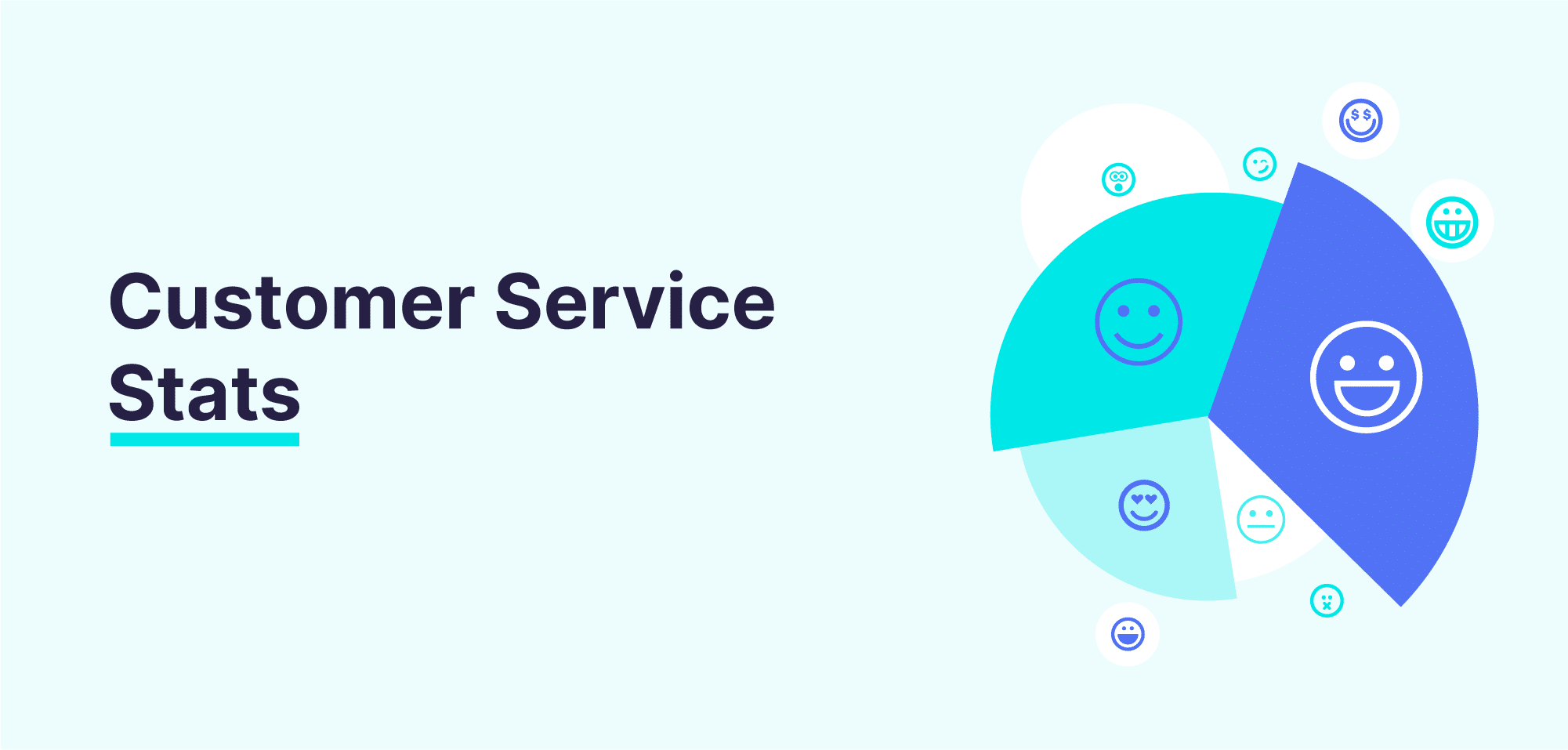What do customers really want? This is the question that all businesses, big or small, must answer. After all, without customers, there would be no business. Understanding what drives customer behavior and how to give them the best possible experience is essential. This article will explore the top service statistics of customers for 2025. Understanding these trends allows you to adapt your customer service strategy accordingly and give your customers what they want.
Related article: How to Turn an Angry Customer into a Happy Customer in 2022
Impact of great customer service
Great customer service has a profound impact on businesses across various industries. Here are some key aspects highlighting the significance of providing exceptional service:
- Customer Satisfaction and Loyalty: Exceptional service directly influences customer satisfaction. Research shows that 89% of customers have changed loyalties because of poor customer service. When customers receive prompt, helpful, and personalized support, it fosters a positive experience, leading to increased customer loyalty. Satisfied customers are more likely to remain loyal, make repeat purchases, and recommend the business to others.
- Brand Reputation and Differentiation: Outstanding service helps build a strong brand reputation. When customers have positive interactions and receive reliable support, it enhances the brand’s image, making it stand out from competitors. Research indicates that 60% of customers have switched to a competitor following a bad customer experience. Therefore, providing exceptional service becomes essential for creating a positive brand reputation and differentiating the business in the market.
- Customer Retention and Revenue Growth: Retaining existing customers is crucial for sustained business growth. By providing exceptional service, businesses can retain their customer base and reduce customer churn. Loyal customers not only continue to support the business but also have a higher lifetime value, contributing to revenue growth and profitability.
- Word-of-Mouth Marketing: Positive word-of-mouth is a powerful marketing tool, and great customer service generates organic referrals. When customers have exceptional experiences, they are more likely to share their positive encounters with friends, family, and colleagues. This word-of-mouth promotion can lead to new customer acquisition without significant marketing costs.
- Competitive Advantage: In a competitive market, outstanding service can be a key differentiator. When businesses prioritize customer satisfaction, it sets them apart from competitors who may overlook this aspect. Exceptional service to customers becomes a competitive advantage that attracts and retains customers, ultimately contributing to market leadership.
In conclusion, great customer service has a wide-ranging impact on businesses, including increased customer satisfaction, loyalty, and retention. It helps shape a positive brand reputation, drives revenue growth, generates word-of-mouth referrals, provides a competitive edge in the market, and fosters employee engagement.
If you want to grow your business, know the differences between Customer Success vs. Customer Service.
Cost of bad customer service
It costs businesses more to acquire new customers than to retain existing ones. In fact, acquiring new customers can cost up to 25 times more. And yet, companies still continue to pour money into acquiring new customers while neglecting the ones they already have.
One reason is that the cost of bad customer service is often hidden. It’s not always obvious how costly it is to lose a customer, but the consequences can be far-reaching. When customers have a bad experience, they don’t just walk away. They tell their friends, write negative reviews, and might even take legal action. The following statistics show how bad customer service can seriously cost your business.
- After just one negative experience, more than half (61%) of the customers say they would move to a competitor; this number rises to 76% in the case of multiple negative experiences.
- A study found that 20-33% of customers have rated their provider’s online services from bad to terrible.
- Fewer than 1 in 5 consumers think that customer service is doing a good job.
The cost of bad customer service can be divided into three main categories: direct, indirect, and opportunity costs.
- Direct costs are the most obvious and include things like refunds, chargebacks, and lost business.
- Indirect costs are harder to quantify but can be just as significant. These include the reputational damage caused by negative reviews and social media posts and the time and resources spent dealing with complaints and managing churn.
- Opportunity costs are perhaps the most difficult to calculate but can be the most consequential in the long run. They include things like missed sales opportunities and future revenue growth potential. When a business fails to deliver on its promises, it not only loses out on immediate sales but also misses out on future opportunities for growth.
In order to combat the high cost of bad customer service, businesses need to focus on delivering an exceptional customer experience, i.e., going above and beyond to meet customer expectations at every touchpoint. It also requires companies to have a deep understanding of their customers so that they can anticipate their needs and proactively address any problems.
Delivering an exceptional customer experience requires businesses to make a significant investment in time and resources. The long-term benefits, which include increased customer loyalty, referrals, and revenue, are worth the effort as they far outweigh the costs.
ROI of good customer service

The following statistics highlight how good customer service positively impacts your return on investment(ROI):
- 75% of customers say that word-of-mouth information about a business is more influential or equal to any other form of marketing and will instead buy from companies that give them good service.
- When it comes to service, customers are looking for companies that go the extra mile. 82% of them will spend more money on a company that offers excellent online service.
- There is immense potential for a small increase in customer retention. A 5% increase translates to a gain of 25% in profits over the course of one year.
Good customer service is essential to business success across industries. It’s also a significant factor in determining whether customers will continue doing business with you. Given the importance of customer satisfaction, it’s essential to understand the ROI of good customer service.
Customer Lifetime Value (CLV)
There are several ways to measure the ROI of customer service, but one of the most important is the customer lifetime value (CLV). CLV measures the revenue a customer will generate for your business over the course of their relationship with you. A high CLV means that a customer is likely to stick around and spend more money with you over time, while a low CLV indicates that a customer is less likely to be loyal and may even take their business elsewhere.
A number of factors contribute to CLV, but customer satisfaction is at its core. Satisfied customers will remain loyal and continue doing business with you, while dissatisfied customers will move their business elsewhere. Given the importance of customer satisfaction to CLV, it’s clear that providing good customer service can significantly impact your bottom line.
Increased sales and higher profits
In addition to impacting CLV, good customer service can also lead to increased sales and higher profits. Happy customers will likely buy from you again and also recommend your products or services to others. They’re also more likely than unhappy customers to forgive occasional mistakes or problems. On the other hand, unhappy customers are more likely to bad-mouth your business to others, which will damage your brand and reputation and deter potential customers from doing business with you.
Save on customer support resources
Finally, good customer service can help save money by reducing the need for customer support. When customers are happy with your products or services, they’re less likely to need help from customer service. This means you can save on customer support costs, which can add up over time.
When it comes to the ROI of good customer service, there’s no doubt that it pays to invest in providing great service, with technology and a team of strong support agents. Satisfied customers are more loyal, more likely to buy from you again, and less likely to need costly customer support. In other words, happy customers are good for business! Therefore, it is time to leverage the power of automation and AI to ensure today’s customers that their needs can be met instantly, and exceedingly well.
Power of customer service automation and AI

Customer service automation and AI can help you improve your customer service in a number of ways. For one, automation can help you speed up your responses to customers. AI can also help you better understand your customers’ needs and provide them with more personalized service. Additionally, AI can help you identify potential issues before they become problems and nip them in the bud.
The following statistics show how AI and automation can be useful for improving your customer service:
- 86% of customers now expect to be able to perform tasks on their own without contact with customer service.
- More than 59% of consumers rated their interactions with AI customer support as at least an 8 out of 10.
- Nearly 17% of customers rated their AI interactions to be a perfect 10 out of 10.
- 68% of customer service agents report feeling overwhelmed. Automation and AI can make their job easier, saving them time and energy so they can focus on their clients’ needs.
Related article: How to deliver consistently good customer service
Conclusion
As we head into 2025, keeping an eye on customer service trends, and how technology can help your business is important. After all, happy customers are the lifeblood of any business. In the eyes of today’s consumers, good service is invaluable. And to succeed, you’ll need to provide your customers with outstanding service from start to finish. We hope that these statistics about customer service have shown you how important it is for your business. This article aims to show how you, too, can deliver the best service experience possible for your customers.


















